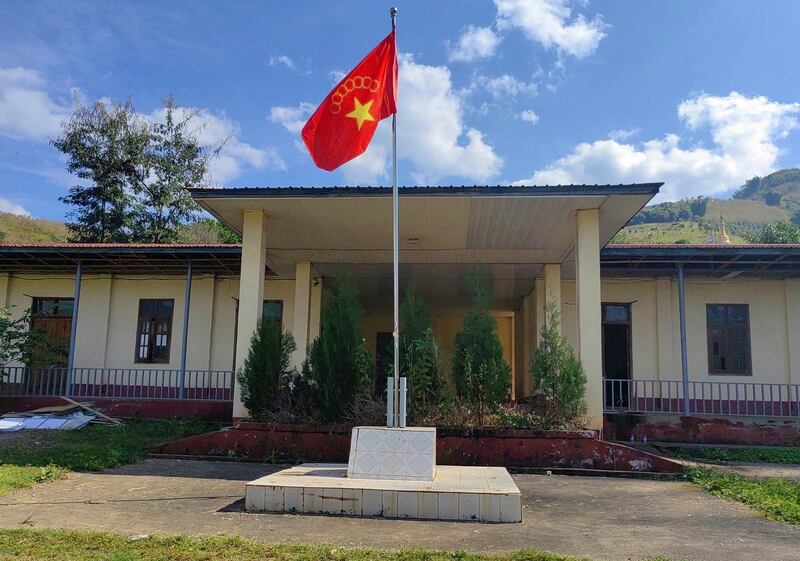Myanmar’s junta chief Senior General Min Aung Hlaing confirmed the loss of several military outposts in northern Shan state to an ethnic rebel offensive in the region, in a rare acknowledgement of the month-long campaign’s successes.
Speaking at a meeting in the capital Naypyidaw on Monday, Min Aung Hlaing admitted that junta forces had “abandoned some posts” in the state due to “Operation 1027,” an offensive launched Oct. 27 by the “Three Brotherhood” Alliance of the Myanmar National Democratic Alliance Army, or MNDAA, the Arakan Army and the Ta’ang National Liberation Army.
The rebels say they have made notable gains against the military in several key cities in Shan state and claim to have captured more than 170 military outposts since the start of the campaign.
In comments carried by state broadcaster MRTV, the junta chief attributed the alliance’s victories to its use of “excessive strength” and technologies that included “military-grade drones” bombing targets from the air, but said that some posts were simply abandoned in consideration of the lives of junta soldiers and their families.
Min Aung Hlaing also suggested that “a number of foreign experts” had assisted the rebels in their campaign, but did not provide details about the claim.
According to pro-junta media, with the inclusion of fighters from the ethnic Kachin Independence Army, the Three Brotherhood Alliance has deployed nearly 6,500 soldiers as part of Operation 1027 and dropped some 25,000 aerial explosives in attacks on the outposts.
Soldiers surrendering
The comments came amid reports of more junta soldiers surrendering.
The MNDAA said on Thursday that its forces had accepted the surrender of the military’s entire 125th Light Infantry Battalion in Shan’s Kone Kyan township on Nov. 28. The group said that three junta battalions had also surrendered in the Kokang Self-Administered Zone in northern Shan state on Wednesday, without providing details.
Earlier, RFA learned that around 300 junta soldiers and police – including two full battalions – surrendered to armed resistance forces in five states on Nov. 21.

Li Kyarwen, the spokesperson of the Myanmar National Democratic Alliance Army, or MNDAA, denied the accusation in an interview with RFA Burmese.
“He is trying to hide the disintegration of the military. But that said, we did use ‘excessive strength,’” he said. “I don’t know who the ‘foreign experts’ are that he referred to, and he only mentioned ‘a number’ of experts … [which] reflect his poor management.”
Li Kyarwen said that if the alliance had used “foreign experts” it would have been even more successful in its campaign.
Min Aung Hlaing alleged during a Nov. 8 meeting of the National Defense and Security Council that the drones used by the alliance in northern Shan state had been “made in China” and are “easily available” in markets along the countries’ shared border.
Creating an ‘invasion narrative’
Former naval Capt. Zay Thu Aung, who now advises resistance forces as part of the country’s anti-junta Civil Disobedience Movement, said that Min Aung Hlaing is trying to “create an invasion narrative” without conceding defeat.
“He said that we have launched attacks with the support of foreign countries, but he is the one who created this war,” he said.
Zay Thu Aung added that finding drone experts has been difficult, and chalked the rebel drone forces’ successes up to “the technological advantages of ethnic armed groups and the skills of our younger generation.”
“Meanwhile, the morale of junta soldiers is low, but he assumes [we are winning because] foreign countries are providing assistance,” he said.
The military has been “gradually losing its outposts,” Zay Thu Aung said, while the alliance forces have “completely controlled the China-Myanmar border.”
Paramilitary groups operating under the shadow National Unity Government, or NUG, have said that their use of drones has increased this year, although they have been unable to provide details, citing security concerns or sensitivity regarding their military matters.
None of the groups has yet issued figures for the number of drone attacks this year, however.
In September, NUG Ministry of Defense Deputy Secretary Maung Maung Swe told RFA that the shadow government made up of former civilian leaders and anti-junta activists has distributed more than 400 attack drones to loosely controlled paramilitary groups.
The number of drones in use by Myanmar’s various ethnic rebel forces is even more opaque.
Blaming China for losses?
Political and military commentator Than Soe Naing said Thursday that Min Aung Hlaing’s comments, taken together with those he made earlier this month, appear to blame China for the junta’s defeats in northern Shan state.
“It was simply good military strategy by the Three Brotherhood Alliance’s ‘Operation 1027’ that forced the military’s troops to abandon their outposts,” he said.
Than Soe Naing noted that alliance forces had attacked more than 200 military outposts since the start of the operation, and that the military had been effectively blocked from sending reinforcements.
“The [junta] is indirectly accusing China of supplying drones in the northeastern part of the country,” he said. “They are providing illogical reasons for their loss.”
Translated by Aung Naing. Edited by Joshua Lipes and Malcolm Foster.

